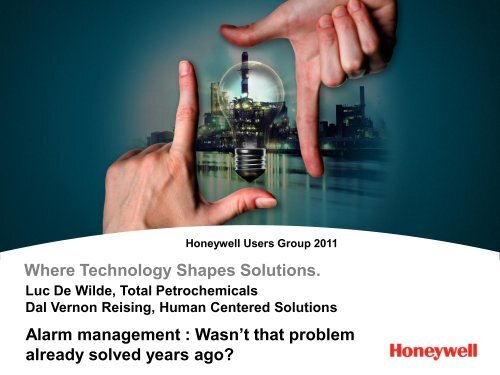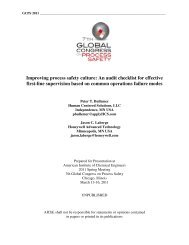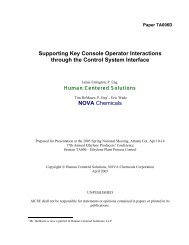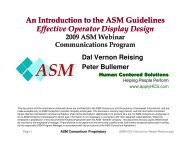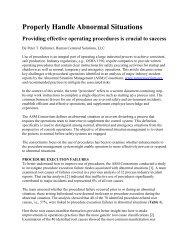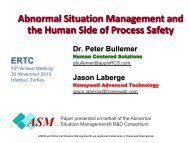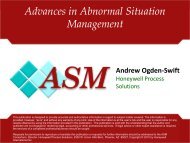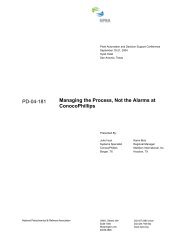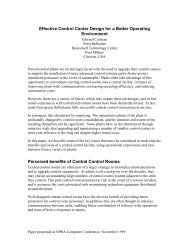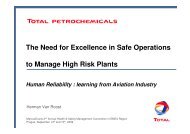Alarm Management: Wasn't that problem solved ... - ASM Consortium
Alarm Management: Wasn't that problem solved ... - ASM Consortium
Alarm Management: Wasn't that problem solved ... - ASM Consortium
Create successful ePaper yourself
Turn your PDF publications into a flip-book with our unique Google optimized e-Paper software.
Honeywell Users Group 2011Where Technology Shapes Solutions.Luc De Wilde, Total PetrochemicalsDal Vernon Reising, Human Centered Solutions<strong>Alarm</strong> management : Wasn’t <strong>that</strong> <strong>problem</strong>already <strong>solved</strong> years ago?
Outline• The Historical context• What is the state of <strong>Alarm</strong> System performance today?• The <strong>ASM</strong> Effective <strong>Alarm</strong> <strong>Management</strong> PracticesGuidelines– Critical guidelines vs. State of practice– Review of „Critical Few‟ guidelines• Current <strong>ASM</strong> <strong>Consortium</strong> alarm management research• Conclusions2
Some history1975 : the first DCS was born3
With the DCS came Endless Possibilities• We can actually see the Process Value, the Setpoint,the Output Value• We can control much more accurately the process• We can reduce the number of operators• We can give the operator all the information he needs• We can give the operator all the alarms he needs, andmoreover : they are free of charge4
The hangover• Help, we are drowning in information(even without alarms)– Needed a better HMI approach than singlescreen-single display, drill-in approach• Help, we are continuously bombardedwith alarms, even when the plant isstable– Still need a better approach to alarm design• Help, we are swept away by alarmfloods when the plant is not stable• Still need a better approach to alarm design5
The taskforce• Review alarm limits• Fix instrumentation errorsDon‟t spend too much time on it :“Operators will get used to it”6
It got worse• New units, expansions => more alarms• Larger control centers• Several accidents related to alarm floods, missedalarms7
The solution (?)• Structured approach, laid out in guidelines andindustry standards :– <strong>ASM</strong> <strong>Consortium</strong> Guideline : Effective <strong>Alarm</strong> <strong>Management</strong>Practices– EEMUA 191– ISA 18.02• ALARM MANAGEMENT PROJECTS :– <strong>Alarm</strong> rationalization– Advanced techniques– Based on the guidelines and standards8
Still <strong>problem</strong>s : some quotes• “Each department has their own ideas about the alarmsystem”• “<strong>Alarm</strong> rationalization only has impact on standingalarms, we still experience alarm floods”• “Very soon after the alarm management project, thenumber of alarms went up again”• “<strong>Alarm</strong> management is a <strong>problem</strong> for the DCS engineer”9
Still <strong>problem</strong>s : some quotes• “Does anybody still know why the alarm limit of <strong>that</strong> tagis set on <strong>that</strong> value ?”• “Every time we expand the unit, we are again drownedin alarms”• “We think our operators don‟t always act on alarms”• “The operators are still feeling uncomfortable : theyrather prefer to see too many alarms than to have analarm removed”10
2878239128862189290224631568144629502127176610581258147218281030178810551408244616551011173021621899146521292730145014562737276627831530195914821340<strong>Alarm</strong> Rate (No. per 10 Min.)<strong>ASM</strong> <strong>Alarm</strong> System Performance Benchmarking10.09.0Monthly Overall Average <strong>Alarm</strong> Rate per ConsoleEEMUA AcceptabilityVery likelyunacceptable8.07.06.0The median overall avg. alarm ratefor the <strong>ASM</strong> Phase 1 and 2 studies =1.77 alarms/ 10 minLikely over demanding5.04.03.02.01.00.0Possibly overdemandingManageableVery likely acceptableConsole ID• Overall Average <strong>Alarm</strong> Rates– The overall average alarm rate across the <strong>ASM</strong> studies’ was 2.3 alarms per 10 minutewindow; the median was 1.8 alarms per 10 minute window– Sites can meet and sustain the EEMUA “Manageable” and “Very likely to be acceptable”levels of overall average alarm rate performance11
5x>5x3x-5x3x-5x3x-5x2.0-2.9x2.0-2.9x2.0-2.9x2.0-2.9x2.0-2.9x2.0-2.9x2.0-2.9x1.0-1.9x1.0-1.9x1.0-1.9x1.0-1.9x1.0-1.9x1.0-1.9x1.0-1.9x1.0-1.9x1.0-1.9x1.0-1.9x1.0-1.9x1.0-1.9x
0-20%0-20%0-20%0-20%>5x>5x3x-5x3x-5x3x-5x2.0-2.9x0-20%2.0-2.9x0-20%2.0-2.9x0-20%2.0-2.9x0-20%21-40%21-40%21-40%21-40%41-60%41-60%61-80%61-80%61-80%61-80%81-100%81-100%81-100%81-100%81-100%81-100%81-100%81-100%81-100%81-100%81-100%81-100%81-100%81-100%81-100%81-100%81-100%81-100%81-100%81-100%81-100%81-100%2.0-2.9x2.0-2.9x2.0-2.9x1.0-1.9x1.0-1.9x1.0-1.9x1.0-1.9x1.0-1.9x1.0-1.9x1.0-1.9x1.0-1.9x1.0-1.9x1.0-1.9x1.0-1.9x1.0-1.9x
<strong>ASM</strong> <strong>Alarm</strong> System Performance Benchmarking• Performed a Best-subsets (i.e., multivariate) regression forOverall Average <strong>Alarm</strong> Rate with 14 metrics (out of the morethan 30 collected)• The resulting multivariate regression model accounted foronly ~50% of the variance in the data• The factors considered significant were:– Degree of rationalization (negative coefficient)– Frequency of monitoring average alarm rate (positivecoefficient; a surprising result)– Degree of control sophistication (negative coefficient)– Frequency of monitoring worst actors (negative coefficient)– Average number of standing alarms (positive coefficient)There is no single “Silver Bullet” to alarm system performance14
15“We have been working on alarmmanagement since years. Why dowe then still feel <strong>that</strong> we haven‟t<strong>solved</strong> the <strong>problem</strong> ...?”
“We have been working on alarmmanagement since years. Why dowe then still feel <strong>that</strong> we haven‟t<strong>solved</strong> the <strong>problem</strong> ...?”Are we taking a systems-approachto our <strong>Alarm</strong> System Performance<strong>problem</strong>s?Or, are we only doing a subset ofthe recommended practices?16
Effective <strong>Alarm</strong> <strong>Management</strong> Practices<strong>ASM</strong> Guidelines document• Three main practice areas– <strong>Management</strong> Practices– <strong>Alarm</strong> System Design & Implementation– Training• 42 guidelines in total across thesepractice areas– Priority “1” – one of the minimum set of guidelinesfor achieving an <strong>ASM</strong> good quality practice.– Priority “2” – one of the comprehensive set of guidelines for achievingan <strong>ASM</strong> high quality practice.– Priority “3” – one of the advanced set of guidelines for achieving an<strong>ASM</strong> best practice.Which are Critical for Success and which are Sites Practicing today?(The following slides are based on presenter experience & opinion, not a scientific survey.)17
<strong>ASM</strong> Guidelines – Critical to Success* <strong>Management</strong> Practices *GL # GL Priority GL StatementCritical to Success Sites Doing It<strong>Management</strong> Practices Yes Maybe No Most Some Few1.1 1 Establish company management support for alarm management. 1 11.2 1 Develop a plant-wide philosophy for alarm management. 1 11.3 1 Establish an owner for the alarm system and ensure adequate1 1staffing.1.4 1 Use a <strong>Management</strong> of Change (MOC) process for alarm changes. 1 11.5 1 Capture and integrate alarm requests generated from plant reviews. 1 11.6 1 Establish an alarm system's worst actors monitoring program. 1 11.7 1 Ensure <strong>that</strong> plant personnel understand and comply with the alarm 1 1management philosophy.1.8 1 Run frequent backups and inspections of electronic journals. 1 11.9 2 Ensure <strong>that</strong> alarm management is a part of an integrated safety 1 1program.1.10 2 Establish an alarm system performance monitoring program. 1 11.11 2 Periodically validate/enforce alarm settings. 1 11.12 2 Perform periodic alarm rationalization revalidations. 1 11.13 3 Perform periodic alarm impact assessments. 1 11.14 3 Ensure <strong>that</strong> incident reviews include alarm system impact. 1 118
<strong>ASM</strong> Guidelines – Critical to Success vs. Site Practices* <strong>Management</strong> Practices *GL # GL Priority GL StatementCritical to Success Sites Doing It<strong>Management</strong> Practices Yes Maybe No Most Some Few1.1 1 Establish company management support for alarm management. 1 11.2 1 Develop a plant-wide philosophy for alarm management. 1 11.3 1 Establish an owner for the alarm system and ensure adequate1 1staffing.1.4 1 Use a <strong>Management</strong> of Change (MOC) process for alarm changes. 1 11.5 1 Capture and integrate alarm requests generated from plant reviews. 1 11.6 1 Establish an alarm system's worst actors monitoring program. 1 11.7 1 Ensure <strong>that</strong> plant personnel understand and comply with the alarm 1 1management philosophy.1.8 1 Run frequent backups and inspections of electronic journals. 1 11.9 2 Ensure <strong>that</strong> alarm management is a part of an integrated safety 1 1program.1.10 2 Establish an alarm system performance monitoring program. 1 11.11 2 Periodically validate/enforce alarm settings. 1 11.12 2 Perform periodic alarm rationalization revalidations. 1 11.13 3 Perform periodic alarm impact assessments. 1 11.14 3 Ensure <strong>that</strong> incident reviews include alarm system impact. 1 119
<strong>ASM</strong> Guidelines – Critical to Success* <strong>Alarm</strong> System Design & Implementation *GL # GL Priority GL StatementCritical to Success Sites Doing It<strong>Alarm</strong> System Design & Implementation Yes Maybe No Most Some Few2.1 1 Ensure instrument reliability and accuracy. 1 12.2 1 Develop design rules to accommodate all common alarm types. 1 12.3 1 Use common alarms for groups of instruments <strong>that</strong> have common 1 1responses.2.4 1 Provide access to the alarm rationalization information. 1 12.5 1 Minimize chattering alarms. 1 12.6 1 Integrate alarms into process graphics. 1 12.7 1 Provide effective alarm annunciation. 1 12.8 1 Ensure alternative support is available for alarm response. 1 12.9 1 Integrate multiple alarm systems. 1 12.10 1 Install an alarm and event historian. 1 120
<strong>ASM</strong> Guidelines – Critical to Success vs. Site Practices* <strong>Alarm</strong> System Design & Implementation *GL # GL Priority GL StatementCritical to Success Sites Doing It<strong>Alarm</strong> System Design & Implementation Yes Maybe No Most Some Few2.1 1 Ensure instrument reliability and accuracy. 1 12.2 1 Develop design rules to accommodate all common alarm types. 1 12.3 1 Use common alarms for groups of instruments <strong>that</strong> have common 1 1responses.2.4 1 Provide access to the alarm rationalization information. 1 12.5 1 Minimize chattering alarms. 1 12.6 1 Integrate alarms into process graphics. 1 12.7 1 Provide effective alarm annunciation. 1 12.8 1 Ensure alternative support is available for alarm response. 1 12.9 1 Integrate multiple alarm systems. 1 12.10 1 Install an alarm and event historian. 1 121
<strong>ASM</strong> Guidelines – Critical to Success* <strong>Alarm</strong> System Design & Implementation *GL # GL Priority GL StatementCritical to Success Sites Doing It<strong>Alarm</strong> System Design & Implementation Yes Maybe No Most Some Few2.11 2 Establish an alarm improvement project plan. 1 12.12 2 Perform a comprehensive alarm rationalization review. 1 12.13 2 Provide an alarm configuration database. 1 12.14 2 Establish a new project execution protocol. 1 12.15 2 Provide safety system design and safety-related alarm handling. 1 12.16 2 Segregate diagnostic information and notifications from1 1annunciated alarms.2.17 2 Implement an alarm shelving/disabled application. 1 12.18 3 Provide online access to alarm rationalization information. 1 12.19 3 Define operating targets and limits appropriate to the mode of1 1operation.2.20 3 Provide dynamic alarm management. 1 12.21 3 Provide a system for user-initiated notifications. 1 12.22 3 Provide advanced applications to support situation awareness. 1 122
<strong>ASM</strong> Guidelines – Critical to Success vs. Site Practices* <strong>Alarm</strong> System Design & Implementation *GL # GL Priority GL StatementCritical to Success Sites Doing It<strong>Alarm</strong> System Design & Implementation Yes Maybe No Most Some Few2.11 2 Establish an alarm improvement project plan. 1 12.12 2 Perform a comprehensive alarm rationalization review. 1 12.13 2 Provide an alarm configuration database. 1 12.14 2 Establish a new project execution protocol. 1 12.15 2 Provide safety system design and safety-related alarm handling. 1 12.16 2 Segregate diagnostic information and notifications from1 1annunciated alarms.2.17 2 Implement an alarm shelving/disabled application. 1 12.18 3 Provide online access to alarm rationalization information. 1 12.19 3 Define operating targets and limits appropriate to the mode of1 1operation.2.20 3 Provide dynamic alarm management. 1 12.21 3 Provide a system for user-initiated notifications. 1 12.22 3 Provide advanced applications to support situation awareness. 1 123
<strong>ASM</strong> Guidelines – Critical to Success* Training *GL # GL Priority GL StatementCritical to Success Sites Doing ItTraining Yes Maybe No Most Some Few3.1 1 Provide operators with information and training on alarm system 1 1changes.3.2 1 Ensure alarm rationalization team members understand the alarm 1 1management philosophy.3.3 1 Establish scenario reviews and what if training. 1 13.4 2 Enhance training programs to include situation support tools. 1 13.5 2 Enhance training programs to include process control operators' 1 1routine alarm management duties.3.6 2 Educate process design personnel in alarm management. 1 13.7 3 Use dynamic simulators as alarm management training tool. 1 124
<strong>ASM</strong> Guidelines – Critical to Success vs. Site Practices* Training *GL # GL Priority GL StatementCritical to Success Sites Doing ItTraining Yes Maybe No Most Some Few3.1 1 Provide operators with information and training on alarm system 1 1changes.3.2 1 Ensure alarm rationalization team members understand the alarm 1 1management philosophy.3.3 1 Establish scenario reviews and what if training. 1 13.4 2 Enhance training programs to include situation support tools. 1 13.5 2 Enhance training programs to include process control operators' 1 1routine alarm management duties.3.6 2 Educate process design personnel in alarm management. 1 13.7 3 Use dynamic simulators as alarm management training tool. 1 125
So what are the Take-Aways?• There is no one magic thing <strong>that</strong> can be done to fixyour alarm system performance <strong>problem</strong>s• <strong>Alarm</strong> <strong>Management</strong> needs to be seen as aContinuous Improvement commitment – <strong>that</strong> is alwaysdone as part of a Lifecycle Maintenance work process• Being successful requires a systems approach, not apick-and-choose approach to what guidelines arepracticed– Being successful also means going beyond „minimumpractices‟26
<strong>ASM</strong> <strong>Alarm</strong> <strong>Management</strong> Research History<strong>ASM</strong> Member Sharing Sessions<strong>ASM</strong> Practices<strong>ASM</strong> Site StudiesBest PracticesBenchmarking<strong>ASM</strong>C FormedNIST FundingCollaborative Decision SupportNot By Technology Alone1994Operator NotificationsAEGISMixed Initiative SystemsOperator Experience<strong>Alarm</strong>s From Ops Perspective<strong>ASM</strong> Metrics<strong>Alarm</strong> Metrics<strong>ASM</strong> Metrics Framework1999<strong>Alarm</strong> SuppressionNuisance <strong>Alarm</strong>sOperator Advice<strong>Alarm</strong>RationalizationWork ProcessesBenefits/ROI<strong>Alarm</strong> <strong>Management</strong>Task ForceImprove DCS CapabilitiesRecognized <strong>ASM</strong> Problem1992<strong>Alarm</strong> FloodsMitigation TechniquesTypical PracticesCharacteristics1997<strong>Alarm</strong> SystemMonitoring<strong>Alarm</strong> MetricsBenchmarking200027
<strong>ASM</strong> <strong>Alarm</strong> <strong>Management</strong> Research History<strong>ASM</strong> Member Sharing SessionsOperator DisplayGuidelinesFirst PublicationVisualizing <strong>Alarm</strong>s<strong>Alarm</strong> Summary DisplaysHuman PerformanceModels for <strong>Alarm</strong> ResponseISA SP18 Committee<strong>ASM</strong> RepresentationInteractive <strong>Alarm</strong> SystemAnalysisWorkflowsInteraction RequirementsCorrelated <strong>Alarm</strong>s Algorithms<strong>Alarm</strong> RationalizationWork ProcessesToolsGuidelinesMobile DevicesMobile <strong>Alarm</strong>ingWork Flows2002Audible <strong>Alarm</strong> Design<strong>Alarm</strong> Acoustics<strong>Alarm</strong> Sounds<strong>Alarm</strong> <strong>Management</strong>GuidelinesFirst PublicationBest PracticesOperator CockpitIntegrated User InterfaceWork ProcessesProactive Monitoring2004Visual ThesaurusVisualizing LimitsSituation Awareness<strong>Alarm</strong> FloodsMitigation Techniques (Config)Typical PracticesCharacteristicsAddressing <strong>Alarm</strong>FloodingMitigation Techniques (UI)<strong>Alarm</strong> Throttling2008Information IntegrationMethods for Information Cohesion<strong>Alarm</strong> TuningDeadband/Timer AlgorithmsAddressing <strong>Alarm</strong> FloodingMitigation Techniques (Real-Time)<strong>Alarm</strong> FloodingMitigation Techniques (Real-Time)Continued from 2010201020112003200628
29<strong>ASM</strong> 2008 Addressing <strong>Alarm</strong> FloodingUI Mitigation Technique example
Conclusions• We all know <strong>that</strong> the <strong>Alarm</strong> System Performance <strong>problem</strong> is not<strong>solved</strong> yet• Good alarm system performance – in terms of Average <strong>Alarm</strong>Rate and <strong>Alarm</strong> Flood Rates – is a continuous improvementcommitment– Therefore, <strong>Alarm</strong> <strong>Management</strong> is a DCS Lifecycle Maintenanceactivity• e.g., it‟s not a one-shot rationalization effort– Addressing Average <strong>Alarm</strong> rates likely requires different practicesthan addressing <strong>Alarm</strong> Flood rates• To be successful, sites cannot pick and choose recommendedpractices and expect to achieve good alarm system performanceThe <strong>ASM</strong> <strong>Consortium</strong> continues to research alarm <strong>problem</strong>s andpioneer solutions for <strong>Alarm</strong> <strong>Management</strong>30


